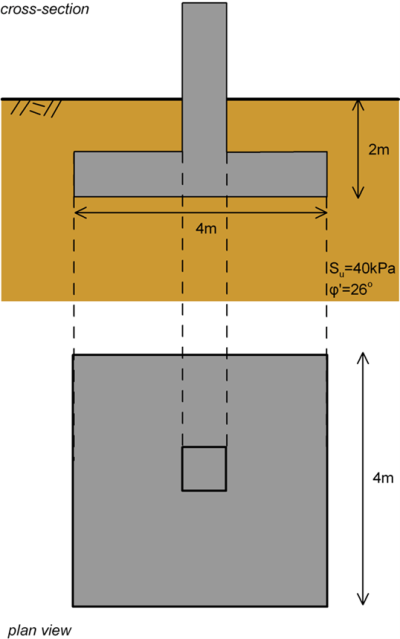Example 5.3
Estimation of the long-term and short-term design capacity of a rectangular footing according to AS5100.3 with the bearing capacity equations
A rectangular footing is embedded in a saturated normally consolidated clay layer. The shear strength parameters of the clay, depicted in the figure below, have been determined by means of triaxial laboratory tests on undisturbed samples. Estimate the design capacity of the footing under short-term and long-term loading conditions according to AS5100.3. Assume γ = 15 kN/m3.
Answer:
As the design load acts at the center of area of the footing, no correction of the footing width and length to their effective values is necessary, thus B′ = B = 4 m and L′ = L = 4 m.
The saturated clay will behave as undrained in the short-term (before excess pore pressure generated by the loading dissipates), therefore we will employ TSA to determine the short-term bearing capacity (e.g., during construction), and from that the collapse load and the design capacity. Accordingly, we will use the ESA formulas to determine the long-term bearing capacity for drained conditions, when all excess pore pressures have dissipated e.g., during the service life of the project (Table 5.4).
The lower of short-term and long-term design capacities is the critical one, to be used for the design of the footing (that is if load and geotechnical reduction factors are the same during construction and during service, as we assume here). However, as the clay is normally consolidated, we can expect undrained loading to be critical (see Figure 5.9).
Since the load is not inclined, we will use the net bearing capacity equations 5.24 and 5.25 together with the shape and embedment correction factors and Eq. 5.23 to add the beneficial contribution of the overburden pressure. No groundwater table is present so a reduction of the long-term bearing capacity for groundwater effects is not required.

1. Short-term design capacity
We will use Eq. 5.24:
![]()
The shape, sc and embedment, dc factors for undrained conditions are calculated from Table 5.5 as:
![]()
![]()
Thus the short-term net bearing capacity is:
![]()
As the characteristic value of the undrained shear strength was determined from laboratory tests on undistrurbed samples, the appropriate range of the geotechnical strength reduction factor φg from Table 5.1 is φg = 0.45 to 0.60. Selecting conservatively the lower bound of the proposed range, the bearing capacity Eq. 5.23 accounting for embedment Df = 2 m results to the design capacity of the footing (expressed in units of force) as:
![]()
![]()
![]()
![]()
2. Long-term design capacity
We will use Eq. 5.25:
![]()
The bearing capacity factors Νq and Νγ are calculated from Eqs. 5.18 and 5.28, respectively, as:
![]()
The shape sq, sγ and embedment dq, dγ factors for drained conditions are calculated from Table 5.5 as:
![]()
![]()
![]()
![]()
Thus the long-term net bearing capacity is:
![]()
![]()
![]()
Using the same value for the geotechnical strength reduction factor φg = 0.45 as for the short-term loading case, the design capacity of the footing is again calculated as in terms of force:
![]()
![]()
![]()
![]()

